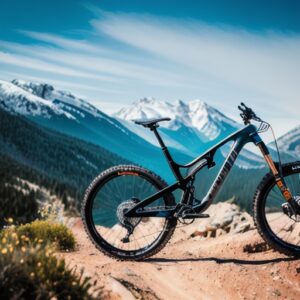The drivetrain is a key component of a mountain bike, essential for transferring power from the rider’s legs to the wheels, enabling the bike to move forward. It consists of various parts working together to create a mechanical system that converts human energy into forward motion.
Drivetrain basics: Crankset and bottom bracket components
At the heart of the drivetrain is the crankset, which includes the pedals and the attached chainrings. When the rider pushes down on the pedals, the crankset rotates, initiating the power transfer process. The chainrings, typically consisting of two or three different-sized rings, allow the rider to select different gear ratios for varying terrains and riding conditions.
Connected to the crankset is the bottom bracket, which houses the bearings and spindle that enable the crankset to rotate smoothly. The bottom bracket is an important component for maintaining drivetrain efficiency and durability.
Key role of the chain in mountain bike drivetrain
The next crucial component is the chain, which loops around the chainrings of the crankset and engages with the rear cassette. The chain is responsible for transferring power from the rider’s pedaling motion to the rear wheel. It needs to be properly lubricated and well-maintained to ensure smooth operation and minimize wear.
Rear cassette: Adjusting gears for optimal mountain bike performance
The rear cassette, mounted on the rear wheel hub, consists of multiple cogs of different sizes. These cogs correspond to the different gears available on the chainrings and determine the bike’s overall gear range. By shifting the chain onto different cogs, the rider can adjust the resistance and find the optimal gear for climbing, descending, or riding on flat terrain.
Smooth gear shifting: Derailleurs and shifters in mountain bikes
To facilitate gear shifting, mountain bikes are equipped with derailleurs—a front derailleur and a rear derailleur. The front derailleur moves the chain between the chainrings, while the rear derailleur shifts the chain across the cogs of the cassette. Shifters, typically mounted on the handlebars, control the derailleurs, allowing the rider to change gears effortlessly while riding.
Transmission
The drivetrain is the part of the bike that transmits the rider’s power to the rear wheel, and it allows the rider to change gears and adjust their pedaling effort to match the terrain and their riding style. The drivetrain on a mountain bike typically consists of the crankset, the bottom bracket, the chain, the cassette, the derailleurs, and the shifters. These components work together to provide the rider with a range of gears, and they allow the rider to shift gears smoothly and efficiently, even under load and on rough terrain.
Components
The drivetrain components on a mountain bike can be made of different materials, such as aluminum, steel, or carbon fiber, which can affect their performance and durability. Aluminum components are the most common and economical option, and they provide good strength and stiffness for most riders. Steel components are heavier and less stiff, but they are also more durable and more resistant to wear and damage. Carbon fiber components are the lightest and stiffest option, but they are also the most expensive and the most fragile. The right drivetrain components for a mountain bike will depend on the rider’s weight, riding style, and terrain.
Cassette
The cassette is the part of the drivetrain that attaches to the rear hub, and it contains the sprockets or cogs that the chain rides on. The cassette can have different numbers of sprockets, such as 9, 10, or 11, which can affect the bike’s gear range. A cassette with more sprockets will provide a wider range of gears, but it will also add more weight and require more precise shifting. A cassette with fewer sprockets will provide a narrower range of gears, but it will also be lighter and easier to shift. The right cassette for a mountain bike will depend on the rider’s individual preferences and the type of terrain they will be riding on.
Chain
The chain is the part of the drivetrain that connects the crankset to the cassette, and it transfers the pedaling force from the rider to the rear wheel. The chain can have different sizes, such as 1/2 inch x 11/128 inch or 1/2 inch x 11/128 inch, which can affect its compatibility with the other drivetrain components. The chain can also have different materials, such as steel or nickel-plated steel, which can affect its durability and performance. A steel chain is the most common and economical option, and it provides good strength and durability for most riders. A nickel-plated chain is more expensive and more corrosion-resistant, but it is also less durable and less compatible with some drivetrain components. The right chain for a mountain bike will depend on the rider’s individual preferences and the type of terrain they will be riding on.
In addition to these primary components, the drivetrain also includes other supporting parts such as shift cables, cable housings, and pulley wheels. These elements work together to ensure precise and reliable gear shifting.
When selecting a mountain bike drivetrain, riders consider factors such as the number of gears, gear range, weight, and overall durability. Different drivetrain manufacturers, such as Shimano, SRAM, and Campagnolo, offer a range of options to suit various riding preferences and budgets.

